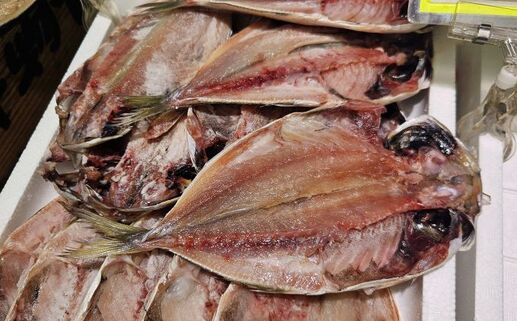2024.08.08
伝検ニュースアジの開きは韓国産、ホッケは米国産―干物の原料に輸入魚浸透
時事通信水産部長 川本大吾

アジの開き。長崎県産などのほか、韓国産を中心に外国産の原料を使って生産されることも多い。
2024年5月30日、東京都中央区の築地場外市場【時事通信社】
日本の伝統食とも言える魚の干物に、外国産の原料がじわり浸透している。製造するのは国内各地の水産加工業者だが、かつて地元でたくさん取れていた魚の水揚げが少なく、原料を確保できなくなっており、輸入魚を使う機会が増えている。
◇韓国産など輸入原料が7割
干物の名産地、神奈川県小田原市の加工業者「山安」では、古くからアジの開きを作ってきた。しかし、近場の漁港でアジを調達できなくなったため、「今は韓国産を中心に、北欧産などを含めて輸入原料が7割近くを占めるようになった」という。
静岡県の沼津市でも、輸入原料への依存度は高い。同市の加工業者によると、「地元で取れるアジはごくわずか。良質のアジをコンスタントに仕入れることはできない」という。国産の干物に向く原料を求めて、遠く長崎県などの漁港で水揚げされたアジを扱っているが、それでも十分な原料を確保できないため、この業者は「オランダやアイルランド産のほか、近年は韓国産を仕入れるケースが多い」と話す。
◇文化干しはノルウェー産のサバ
干しサバも外国産が主流となっている。サバの主産地である千葉県銚子市の水産加工業者「丸安」によると、乾燥機を使った「文化干し」の原料は「銚子港の水揚げが不安定なため、かなり前からノルウェー産を使っている」と話す。同社では、十数年以上前に銚子に揚がったサバを使ったことがあるが、加工に向く質と量が賄えずに継続的な仕入れはできなかった。「国内の他産地のサバも探したが見つからず、ノルウェー産のサバで、ずっと文化干しを作り続けている」という。
急激な円安により、仕入れ値は高くなっている。それでも、丸安は「十分な量が確保できることと、脂の乗りが良いことなど、ノルウェー産のサバにはいい干物を作るのに必要な条件がそろっている」と説明する。高品質のサバの干物を安定的に生産するには、今や国産の原料では賄えないようだ。
◇人気急上昇、米国産のシマホッケ
首都圏の台所、東京・豊洲市場(江東区)の加工品専門卸、丸千千代田水産によると、アジやサバのほか、ホッケの開き干しも外国産が目立つという。ホッケはかつて国産のマホッケが中心で、米国産のシマホッケは「水っぽくて不人気だった時期があった」という。ところが、同社は「最近は、焼いて食べるときに身離れが良くて食べやすく、脂が乗っておいしいと人気が上がり、居酒屋を中心に料理店からの注文が絶えない」と明かす。従って今ではホッケと言えば、マホッケではなく、シマホッケがメジャーになっている。
このほか、同社によると「干したシシャモは国産原料が少なく、ノルウェーやアイスランド産が使われている。ハタハタやカマスは国産が少ないものの、外国産の代替原料がなくて品薄気味」となっている。
◇輸入原料で伝統の味を継承
干物原料に輸入魚を使うことが増える一方、カタクチイワシなどを使った目刺しや煮干し、シラス干し、ムロアジなどを使った「くさや」といった干物については、十分な国産原料があることなどから、輸入魚を使う必要もないようだ。
水産加工物には製造者(加工業者)の所在地のほか、原料原産地の表示が義務付けられており、干物などを買う際、輸入魚を使った干物などの情報もラベルなどで確認できる。「小田原加工」「銚子加工」などと表示されていても、原料が外国産であるケースは今後も増えそうだ。
円安に加え、世界的に魚需要が高まっているため、日本も簡単に安く魚を輸入できる環境ではなくなっている。各地の加工業者は、かつては地元の魚を使った保存食として干物を生産してきたが、状況は大きく変化した。輸入魚をうまく活用しながら、自慢の干物を作ることで伝統的な製法を守り続けている。
▼時事ドットコムニュース 連載 「大漁! 水産部長の魚トピックス」より
カテゴリー: 伝検ニュース
関連タグ: #食文化





